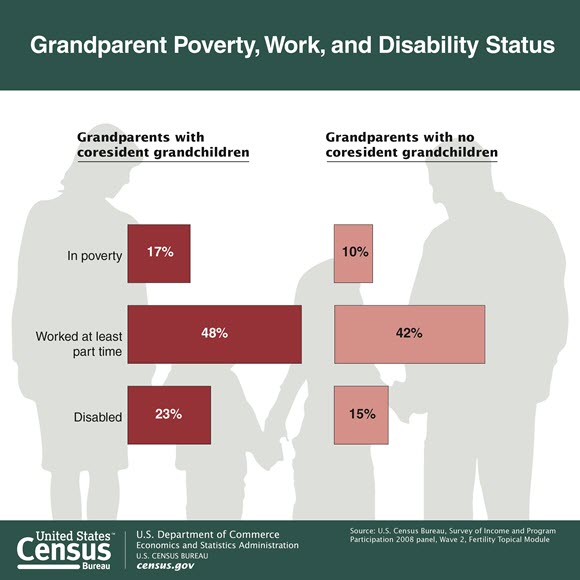
An official website of the United States government
Here’s how you know
Official websites use .gov
A .gov website belongs to an official government organization in the United States.
Secure .gov websites use HTTPS
A lock (
) or https:// means you’ve safely connected to the .gov website. Share sensitive information only on official, secure websites.
-
//
- Census.gov /
- Census Blogs /
- Random Samplings /
- Grandparents Who Live with a Grandchild are Younger and More Likely to be in Poverty
Grandparents Who Live with a Grandchild are Younger and More Likely to be in Poverty
Grandparents Who Live with a Grandchild are Younger and More Likely to be in Poverty
The Survey of Income and Program Participation is the only U.S. census survey that asks questions about grandparents who do not live with their grandchildren. In the Coresident Grandparents and Their Grandchildren: 2012 report, we used the 2008 survey for the first time to compare grandparents who lived with grandchildren to grandparents who did not. There were about 65 million grandparents in the United States in 2009. About 10 percent of those grandparents lived with at least one grandchild.
Grandparents with coresident grandchildren were younger, on average, than those without coresident grandchildren. While only about 5 percent of non-coresident grandparents were under age 44, 11.0 percent of grandparents who lived with grandchildren were under 44. Conversely, about 48 percent of grandparents who did not live with a grandchild were over age 65, while 27 percent of grandparents who lived with a grandchild were over 65.
Grandparents who did not live with their grandchildren were more likely to be married with their spouse present. Sixty-four percent of them were married, compared with 58 percent of grandparents who lived with a grandchild. However, they were also more likely to be widowed or cohabiting. Sixteen percent of nonresident grandparents were widowed and 3 percent were cohabiting, compared with 14 percent widowed and 2 percent cohabiting for coresident grandparents.
Grandparents who did not live with their grandchildren had higher levels of education. Only 14 percent did not graduate from high school, compared with 28 percent of coresident grandparents. Thirty-three percent of non-coresident grandparents completed at least some college, and 19 percent had a bachelor’s degree or higher. In comparison 28 percent of coresident grandparents completed some college, and 11 percent had a bachelor’s or higher.
These educational differences relate to differences in work status and poverty. Fifty-eight percent of non-coresident grandparents were not working, compared with 52 percent of coresident grandparents. Coresident grandparents were more likely to have work limitations because of an illness or disability (23 percent), compared with 15 percent of non-coresident grandparents. Coresident grandparents were also more likely to be in poverty (17 percent) compared with non-coresident grandparents (10 percent).
Share
 Yes
Yes
 No
NoComments or suggestions?


Top

